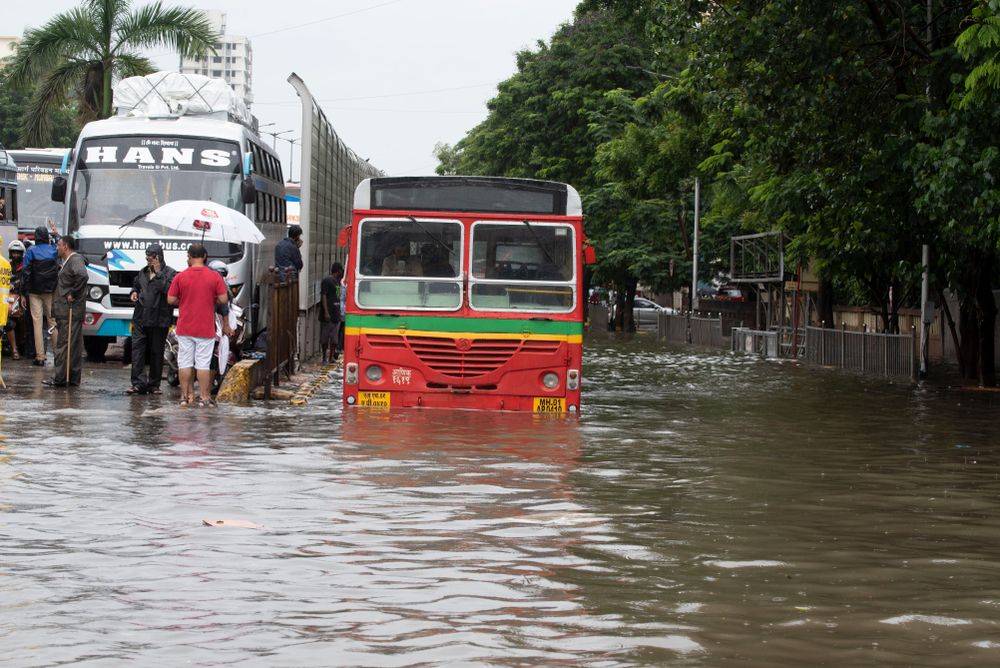Mumbai rains, often called the “city that never sleeps,” is once again grappling with the fury of relentless monsoon rains. Over the past 48 hours, heavy downpour has paralyzed large parts of the financial capital, leaving thousands of commuters stranded, trains disrupted, and flights delayed or canceled. The India Meteorological Department (IMD) has issued a red alert for Mumbai and surrounding areas, warning that heavy to very heavy rainfall is likely to continue in the next 24 hours.


Torrential Rainfall Since Weekend
The downpour began late Saturday evening and intensified through Sunday and Monday. According to IMD data, several areas of Mumbai recorded rainfall between 150 mm and 250 mm in a 24-hour period, well above the average for this time of year. The Santacruz weather station reported nearly 200 mm of rainfall, while Colaba and Chembur received close to 180 mm. Suburban areas like Andheri, Kurla, and Borivali experienced even heavier showers, triggering flash flooding.
Meteorologists attribute the non-stop rainfall to a low-pressure system over the Arabian Sea combined with strong monsoon currents. “This system is drawing large volumes of moisture towards the Maharashtra coast, leading to sustained heavy rainfall,” said a senior IMD official.
City Brought To A Standstill
The intensity of rain has brought Mumbai’s infrastructure to its knees. Major roads, including the Western Express Highway, Eastern Express Highway, and SV Road, were inundated with knee-deep to waist-deep water, making vehicular movement nearly impossible. Office-goers and students were forced to wade through flooded streets, with many abandoning vehicles mid-way due to stalled engines.
Localities such as Sion, Dadar, Kurla, Andheri Subway, and King’s Circle were among the worst affected. Videos circulating on social media showed cars floating in waterlogged underpasses, BEST buses stuck in waist-deep water, and citizens forming human chains to help pedestrians cross flooded intersections.
The Brihanmumbai Municipal Corporation (BMC) deployed pumps to drain extra water, but the sheer volume of rain overloaded drainage infrastructure. In several places, waterlogging persisted for hours even after the rain subsided temporarily.
Train Services Severely Hit
The suburban railway network, Mumbai’s lifeline, was hardest hit by the rain. Services on both the Central and Western Railway lines were disrupted as tracks were submerged in several stretches, particularly near Sion, Kurla, and Vikhroli on the Central line and near Andheri, Goregaon, and Dahisar on the Western line.
Trains were either delayed, short-terminated, or canceled, leaving lakhs of commuters stranded at stations. Passengers complained of overcrowding, lack of clear communication, and being stuck in trains for over an hour without movement. “I boarded a local train at Dadar at 9 AM, but it stopped near Sion due to waterlogging on the tracks. We were inside the train for almost two hours,” said commuter Ravi Sharma, a bank employee.
Long-distance trains departing from Mumbai CST and Lokmanya Tilak Terminus were also delayed by several hours. Some express services were diverted via alternate routes, further straining railway operations.
Flights Delayed and Canceled
The Chhatrapati Shivaji Maharaj International Airport also faced severe disruptions due to heavy rain. Poor visibility, waterlogged runways, and air traffic congestion led to delays in both arrivals and departures. Airport authorities confirmed that over 120 flights were delayed and at least 25 were canceled on Monday.
On social media, a number of travellers complained about having to wait for hours at terminals with few information. Airlines cited “uncontrollable weather conditions” as the reason and urged passengers to check flight status online before heading to the airport.
Power Cuts and Internet Disruption
Apart from transport, heavy rainfall also impacted power supply in parts of the city. Localities in the suburbs, including Chembur, Ghatkopar, Mulund, and Kandivali, experienced power outages lasting several hours. Electricity distribution companies said precautionary shutdowns were carried out in some areas to prevent accidents due to waterlogging.
Mobile and internet connectivity was patchy in several areas, adding to the frustration of residents already battling floods.
Schools and Offices Affected
With roads blocked and trains not running on time, many schools declared a holiday for students. In an advisory, the BMC urged private companies to permit workers to work from home whenever feasible. IT companies and corporate offices in Bandra-Kurla Complex (BKC) and Andheri reported thin attendance.
“Most of our employees couldn’t make it because trains were suspended. We switched to online meetings to keep operations running,” said the HR manager of a leading software firm in Powai.
Human Stories of Struggle
Beyond statistics, the rain spelled misery for ordinary citizens. Daily-wage workers lost earnings as markets and construction sites remained shut. Several slum colonies in Dharavi, Kurla, and Govandi were inundated, forcing residents to move belongings to higher ground.
At King’s Circle, volunteers distributed tea and snacks to stranded commuters. Auto drivers offered free rides to women and children stuck in flooded areas. Social media was filled with appeals for help and information about safe routes.
“We carried my grandmother on a chair across waist-deep water to take her to the hospital. It was terrifying,” said 28-year-old Sameer Sheikh from Kurla.
BMC and NDRF Response
The BMC activated over 200 emergency teams equipped with pumps, lifeboats, and rescue equipment. The National Disaster Response Force (NDRF) was also kept on standby in case of worsening floods.Control rooms were constantly observed by senior personnel.
BMC Commissioner Iqbal Singh Chahal appealed to citizens to avoid unnecessary travel and assured that “all efforts are being made to restore normalcy at the earliest.” Disaster helpline numbers were shared for emergency assistance.
Weather Forecast
The IMD has predicted continued heavy to very heavy rainfall in Mumbai, Thane, and Raigad over the next 48 hours. Fishermen have been advised not to venture into the sea due to rough weather conditions. Citizens have been urged to stay indoors, stock essential supplies, and follow official advisories closely.
Long-Term Concerns
The latest flooding once again raises questions about Mumbai’s preparedness to handle extreme monsoon events. Despite crores spent annually on drainage upgrades and desilting, waterlogging remains a recurring problem. Urban planners blame unplanned construction, shrinking open spaces, and clogged stormwater drains.
Environmentalists have stressed the urgent need to restore mangroves and wetlands that naturally absorb excess rainwater. “Unless Mumbai addresses its ecological imbalances, every monsoon will bring the city to a standstill,” said activist Medha Patkar.
Conclusion
The non-stop rain in Mumbai has highlighted both the resilience and the vulnerability of the city. While authorities scrambled to restore services, ordinary citizens once again rose to the occasion, helping strangers and displaying solidarity in times of crisis.
As the downpour continues, Mumbaikars remain on high alert — balancing their daily struggles with hope that the city, true to its spirit, will bounce back once the skies clear.
Non-Stop Rain in Mumbai Causes Severe Waterlogging, Trains, Flights Affected – NDTV
Explore more updates in our Maharashtra News Section
